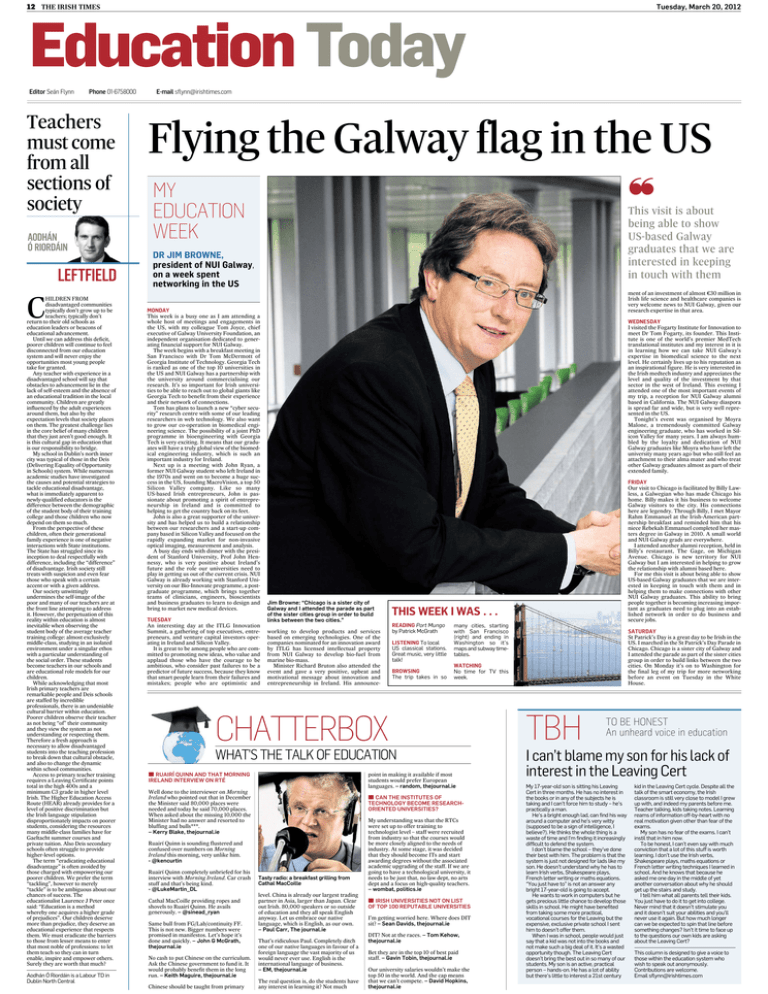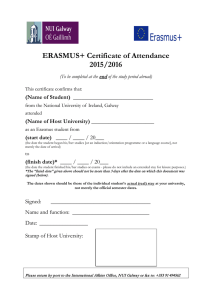Document 14415245
advertisement

12 THE IRISH TIMES Tuesday, March 20, 2012 Education Today Editor Seán Flynn Phone 01-6758000 Teachers must come from all sections of society AODHÁN Ó RIORDÁIN C LEFTFIELD HILDREN FROM disadvantaged communities typically don’t grow up to be teachers; typically don’t return to their old schools as education leaders or beacons of educational advancement. Until we can address this deficit, poorer children will continue to feel disconnected from our education system and will never enjoy the opportunities most young people take for granted. Any teacher with experience in a disadvantaged school will say that obstacles to advancement lie in the lack of self-esteem and the absence of an educational tradition in the local community. Children are greatly influenced by the adult experiences around them, but also by the expectation levels that society places on them. The greatest challenge lies in the core belief of many children that they just aren’t good enough. It is this cultural gap in education that is our responsibility to bridge. My school in Dublin’s north inner city was typical of those in the Deis (Delivering Equality of Opportunity in Schools) system. While numerous academic studies have investigated the causes and potential strategies to tackle educational disadvantage, what is immediately apparent to newly-qualified educators is the difference between the demographic of the student body of their training college and those children who now depend on them so much. From the perspective of these children, often their generational family experience is one of negative interactions with State institutions. The State has struggled since its inception to deal respectfully with difference, including the “difference” of disadvantage. Irish society still treats with suspicion and even fear those who speak with a certain accent or with a given address. Our society unwittingly undermines the self-image of the poor and many of our teachers are at the front line attempting to address it. However, the perpetuation of this reality within education is almost inevitable when observing the student body of the average teacher training college: almost exclusively middle-class, studying in an isolated environment under a singular ethos with a particular understanding of the social order. These students become teachers in our schools and are educational role models for our children. While acknowledging that most Irish primary teachers are remarkable people and Deis schools are staffed by incredible professionals, there is an undeniable cultural barrier within education. Poorer children observe their teacher as not being “of” their community and they view the system as not understanding or respecting them. Therefore a fresh approach is necessary to allow disadvantaged students into the teaching profession to break down that cultural obstacle, and also to change the dynamic within school communities. Access to primary teacher training requires a Leaving Certificate points total in the high 400s and a minimum C3 grade in higher level Irish. The Higher Education Access Route (HEAR) already provides for a level of positive discrimination but the Irish language stipulation disproportionately impacts on poorer students, considering the resources many middle-class families have for Gaeltacht summer courses and private tuition. Also Deis secondary schools often struggle to provide higher-level options. The term “eradicating educational disadvantage” is often avoided by those charged with empowering our poorer children. We prefer the term “tackling”, however to merely “tackle” is to be ambiguous about our chances of success. The educationalist Laurence J Peter once said: “Education is a method whereby one acquires a higher grade of prejudices”. Our children deserve more than prejudice, they deserve an educational experience that respects them. We must eradicate the barriers to those from lesser means to enter that most noble of professions: to let them teach so they can in turn enable, inspire and empower others. Surely they are worth that much? Aodhán Ó Riordáin is a Labour TD in Dublin North Central E-mail sflynn@irishtimes.com Flying the Galway flag in the US ❝ MY EDUCATION WEEK This visit is about being able to show US-based Galway graduates that we are interested in keeping in touch with them DR JIM BROWNE, president of NUI Galway, on a week spent networking in the US MONDAY This week is a busy one as I am attending a whole host of meetings and engagements in the US, with my colleague Tom Joyce, chief executive of Galway University Foundation, an independent organisation dedicated to generating financial support for NUI Galway. The week begins with a breakfast meeting in San Francisco with Dr Tom McDermott of Georgia Institute of Technology. Georgia Tech is ranked as one of the top 10 universities in the US and NUI Galway has a partnership with the university around commercialising our research. It’s so important for Irish universities to be able to reach out to global giants like Georgia Tech to benefit from their experience and their network of connections. Tom has plans to launch a new “cyber security” research centre with some of our leading researchers in web technology. We also want to grow our co-operation in biomedical engineering science. The possibility of a joint PhD programme in bioengineering with Georgia Tech is very exciting. It means that our graduates will have a truly global view of the biomedical engineering industry, which is such an important industry for Ireland. Next up is a meeting with John Ryan, a former NUI Galway student who left Ireland in the 1970s and went on to become a huge success in the US, founding MacroVision, a top 50 Silicon Valley company. Like so many US-based Irish entrepreneurs, John is passionate about promoting a spirit of entrepreneurship in Ireland and is committed to helping to get the country back on its feet. John is also a great supporter of the university and has helped us to build a relationship between our researchers and a start-up company based in Silicon Valley and focused on the rapidly expanding market for non-invasive optical imaging, measurement and analysis. A busy day ends with dinner with the president of Stanford University, Prof John Hennessy, who is very positive about Ireland’s future and the role our universities need to play in getting us out of the current crisis. NUI Galway is already working with Stanford University on our Bio-Innovate programme, a postgraduate programme, which brings together teams of clinicians, engineers, bioscientists and business graduates to learn to design and bring to market new medical devices. TUESDAY An interesting day at the ITLG Innovation Summit, a gathering of top executives, entrepreneurs, and venture capital investors operating in Ireland and Silicon Valley. It is great to be among people who are committed to promoting new ideas, who value and applaud those who have the courage to be ambitious, who consider past failures to be a predictor of future success, because they know that smart people learn from their failures and mistakes; people who are optimistic and ment of an investment of almost ¤30 million in Irish life science and healthcare companies is very welcome news to NUI Galway, given our research expertise in that area. WEDNESDAY I visited the Fogarty Institute for Innovation to meet Dr Tom Fogarty, its founder. This Institute is one of the world’s premier MedTech translational institutes and my interest in it is in learning how we can take NUI Galway’s expertise in biomedical science to the next level. He certainly lives up to his reputation as an inspirational figure. He is very interested in the Irish medtech industry and appreciates the level and quality of the investment by that sector in the west of Ireland. This evening I attended one of the most important events of my trip, a reception for NUI Galway alumni based in California. The NUI Galway diaspora is spread far and wide, but is very well represented in the US. Tonight’s event was organised by Moyra Malone, a tremendously committed Galway engineering graduate, who has worked in Silicon Valley for many years. I am always humbled by the loyalty and dedication of NUI Galway graduates like Moyra who have left the university many years ago but who still feel an attachment to their alma mater and who treat other Galway graduates almost as part of their extended family. Jim Browne: “Chicago is a sister city of Galway and I attended the parade as part of the sister cities group in order to build links between the two cities.” working to develop products and services based on emerging technologies. One of the companies nominated for an innovation award by ITLG has licensed intellectual property from NUI Galway to develop bio-fuel from marine bio-mass. Minister Richard Bruton also attended the event and gave a very positive, upbeat and motivational message about innovation and entrepreneurship in Ireland. His announce- THIS WEEK I WAS . . . READING Port Mungo by Patrick McGrath LISTENING To local US classical stations. Great music, very little talk! BROWSING The trip takes in so many cities, starting with San Francisco (right) and ending in Washington so it’s maps and subway timetables. WHAT’S THE TALK OF EDUCATION point in making it available if most students would prefer European languages. – random, thejournal.ie Well done to the interviewer on Morning Ireland who pointed out that in December the Minister said 80,000 places were needed and today he said 70,000 places. When asked about the missing 10,000 the Minister had no answer and resorted to bluffing and bulls***. – Kerry Blake, thejournal.ie ■ CAN THE INSTITUTES OF TECHNOLOGY BECOME RESEARCHORIENTED UNIVERSITIES? Ruairí Quinn is sounding flustered and confused over numbers on Morning Ireland this morning, very unlike him. - @kencurtin Ruairí Quinn completely unbriefed for his interview with Morning Ireland. Car crash stuff and that’s being kind. - @LukeMartin_DL Cathal MacCoille providing ropes and shovels to Ruairí Quinn. He avails generously. – @sinead_ryan Same bull from FG/Lab/continuity FF. This is not new. Bigger numbers were promised in manifestos. Let’s hope it’s done and quickly. – John G McGrath, thejournal.ie No cash to put Chinese on the curriculum. Ask the Chinese government to fund it. It would probably benefit them in the long run. – Keith Maguire, thejournal.ie Chinese should be taught from primary Tasty radio: a breakfast grilling from Cathal MacCoille level. China is already our largest trading partner in Asia, larger than Japan. Clear out Irish. 80,000 speakers or so outside of education and they all speak English anyway. Let us embrace our native language, which is English, as our own. – Paul Carr, The journal.ie That’s ridiculous Paul. Completely ditch one of our native languages in favour of a foreign language the vast majority of us would never ever use. English is the international language of business. – EM, thejournal.ie The real question is, do the students have any interest in learning it? Not much SATURDAY St Patrick’s Day is a great day to be Irish in the US. I marched in the St Patrick’s Day Parade in Chicago. Chicago is a sister city of Galway and I attended the parade as part of the sister cities group in order to build links between the two cities. On Monday it’s on to Washington for the final leg of my trip for more networking before an event on Tuesday in the White House. WATCHING No time for TV this week. CHATTERBOX ■ RUAIRÍ QUINN AND THAT MORNING IRELAND INTERVIEW ON RTÉ FRIDAY Our visit to Chicago is facilitated by Billy Lawless, a Galwegian who has made Chicago his home. Billy makes it his business to welcome Galway visitors to the city. His connections here are legendry. Through Billy, I met Mayor Rahm Emmanuel at the Irish-American partnership breakfast and reminded him that his niece Rebekah Emmanuel completed her masters degree in Galway in 2010. A small world and NUI Galway grads are everywhere. I attended another alumni reception, held in Billy’s restaurant, The Gage, on Michigan Avenue. Chicago is new territory for NUI Galway but I am interested in helping to grow the relationship with alumni based here. For me this visit is about being able to show US-based Galway graduates that we are interested in keeping in touch with them and in helping them to make connections with other NUI Galway graduates. This ability to bring people together is becoming increasing important as graduates need to plug into an established network in order to do business and secure jobs. My understanding was that the RTCs were set up to offer training to technologist level – staff were recruited from industry so that the courses would be more closely aligned to the needs of industry. At some stage, it was decided that they should become ITs and start awarding degrees without the associated academic upgrading of the staff. If we are going to have a technological university, it needs to be just that, no law dept, no arts dept and a focus on high-quality teachers. – wombat, politics.ie ■ IRISH UNIVERSITIES NOT ON LIST OF TOP 100 REPUTABLE UNIVERSITIES I’m getting worried here. Where does DIT sit? – Sean Davids, thejournal.ie DIT? Not at the races. – Tom Kehow, thejournal.ie Bet they are in the top 10 of best paid staff. – Gavin Tobin, thejournal.ie Our university salaries wouldn’t make the top 50 in the world. And the cap means that we can’t compete. – David Hopkins, thejournal.ie TBH TO BE HONEST An unheard voice in education I can’t blame my son for his lack of interest in the Leaving Cert My 17-year-old son is sitting his Leaving Cert in three months. He has no interest in the books or in any of the subjects he is taking and I can’t force him to study – he’s practically a man. He’s a bright enough lad, can find his way around a computer and he’s very witty (supposed to be a sign of intelligence, I believe?). He thinks the whole thing is a waste of time and I’m finding it increasingly difficult to defend the system. I don’t blame the school – they’ve done their best with him. The problem is that the system is just not designed for lads like my son. He doesn’t understand why he has to learn Irish verbs, Shakespeare plays, French letter writing or maths equations. “You just have to” is not an answer any bright 17-year-old is going to accept. He wants to work in computers but he gets precious little chance to develop those skills in school. He might have benefited from taking some more practical, vocational courses for the Leaving but the expensive, exclusive private school I sent him to doesn’t offer them. When I was in school, people would just say that a kid was not into the books and not make such a big deal of it. It’s a wasted opportunity though. The Leaving Cert doesn’t bring the best out in so many of our students. My son is an active, practical person – hands-on. He has a lot of ability but there’s little to interest a 21st century kid in the Leaving Cert cycle. Despite all the talk of the smart economy, the Irish classroom is still very close to model I grew up with, and indeed my parents before me. Teacher talking, kids taking notes. Learning reams of information off-by-heart with no real motivation given other than fear of the exams. My son has no fear of the exams. I can’t instil that in him now. To be honest, I can’t even say with much conviction that a lot of this stuff is worth learning. I don’t use the Irish verbs, Shakespeare plays, maths equations or French letter writing techniques I learned in school. And he knows that because he asked me one day in the middle of yet another conversation about why he should get up the stairs and study. I tell him what all parents tell their kids. You just have to do it to get into college. Never mind that it doesn’t stimulate you and it doesn’t suit your abilities and you’ll never use it again. But how much longer can we be expected to spin that line before something changes? Isn’t it time to face up to the questions our own kids are asking about the Leaving Cert? This column is designed to give a voice to those within the education system who wish to speak out anonymously. Contributions are welcome. Email sflynn@irishtimes.com

